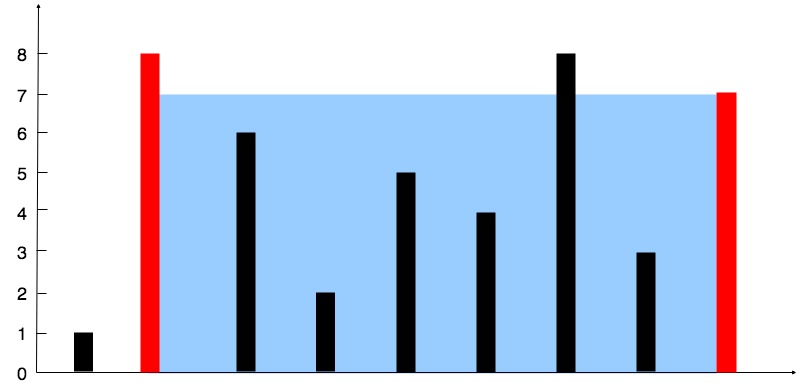ContainerWithMostWater
Description
Given n non-negative integers a1, a2, …, an , where each represents a point at coordinate (i, ai). n vertical lines are drawn such that the two endpoints of line i is at (i, ai) and (i, 0). Find two lines, which together with x-axis forms a container, such that the container contains the most water.
Note: You may not slant the container and n is at least 2.
Example
Input: [1,8,6,2,5,4,8,3,7]
Output: 49
Analysis & Code
题目大意是计算给定的柱子所能围成的最大面积。示例输出如图所示:
首先明确一点,柱子之间的面积由 短板效应 决定,也就是最短的柱子决定了容器的高,而底为横坐标差的绝对值。
General Solution
然后很容易想到,可以利用 双重循环,对每一个柱子,扫描它后面的柱子,每次计算面积,然后更新最大面积。这样保证可以找到最大面积。
算法的时间复杂度是 $O(n^2)$ (实际上是 $\frac{n(n-1)}{2}$)
代码如下:
1 | int maxArea(vector<int>& v) { |
Advanced Solution
上面的算法时间复杂度为 $O(n^2)$,这是由双重循环导致的。可以考虑将循环缩减为一重,那么复杂度就下降到了 $O(n)$。下面来着手考虑如何优化算法。
我们可以发现一个事实,如果两根柱子确定的一个最大的”容量”,这个”容量”是针对较短的柱子而言。那么我们只要计算每一根柱子所能构成的最大”容量”,再比较出最大值,就可以得到所需的输出。
优化思路与证明如下:
假设当前两根柱子为最外侧的两个柱子,其围成的”容量”为V1。接下来,我们选择从某一侧向中间方向”移动”,选择一根新柱子,与另一侧的柱子构成新的”容器”,计算新的”容量”。
这里对于两侧的柱子有两种情况:柱子不等长
如果从较长柱子侧向中间移动,那么对于较短柱子而言,新柱子无外乎三种情况:
比其短
那么高和底都减小了,”容量”减小。
与其等长
高不变,底变小,”容量”减小。
比其长
高不变,底变小,”容量”减小。
从该侧继续向中间移动,对于较短柱子而言,其”容量”都是不断减小的。所以,对于较短的柱子而言,最外侧的柱子是能与其构成最大容量的柱子。
柱子等长
那么无论从哪一侧开始移动,都是一样的,总有一根柱子的最大”容量”已经计算出来了。
我们采用递归的思维可以看出,从最外侧的两根柱子开始,每次选择一根新柱子,递归计算出每一根柱子对应的最大容量,那么答案就在这一次的遍历中。
代码如下:
1 | int maxArea(vector<int>& v) { |
